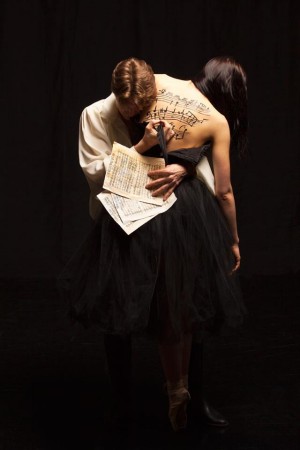Dances with Wolfgang Amadeus Mozart
Ballet Victoria, Royal Theatre, Victoria
May 30-31
Reviewed by Candace Fertile
Ballet Victoria is known for its innovative, eclectic choreography, and Dances with Wolfgang effectively demonstrates the fusion of classic and contemporary. Paul Destrooper, the artistic director of the company, choreographed this latest offering. His personal touch is evident not only in the moves but also the sounds.
Destrooper gave a short introduction to the audience May 30, explaining that the ballet is not a coherent narrative but a series of linked vignettes or images meant to evoke emotion. He noted that musicians, like dancers, face challenges, and focused on the difficulties Mozart had. In a smooth transition, Destrooper spoke of the problems life flung at Freddie Mercury, whose music with Queen is used in the ballet. Most of the music is Mozart’s, with one selection, “Skyfall,” by Adele. As the music of a dance performance affects whether or not I can enjoy it, the choices (especially all the Mozart) were a joy.
The idea of the ballet is to show how Mozart’s imagination was stifled by his job as a court composer. The role of Mozart was danced by Matthew Cluff, and the Muse was Andrea Bayne. The King (Geoff Malcolm, in what may be his last performance with the company) and the Queen (Keika Hayashi) made a memorable couple visually. The rest of the company played attendants, musicians, courtiers, music, and instruments. Destrooper played Death, whose embrace ultimately frees Mozart from the burden of conformity.
The stark set allowed focus on movement. One prop was a table that served several purposes, the most exceptional being a piano with the dancers’ legs becoming the piano keys. Fog infused much of the performance, lending a dreamy quality when Mozart was at the height of his powers, then an oppressive atmosphere when he was suffering at court. The lighting worked well with the clean stage and fog.
The company is a young one, and it’s facing financial trouble, an all-too-often-heard lament from the arts sector in general. Destrooper’s blend of old and new may not be for everyone, but the audience on May 30, while small, was definitely appreciative. The dancers are competent, and the troop is developing. Cluff and Bayne do an excellent job with the varying needs of their roles, and the Attendants (Parisa Mehgregan, Hikari Shigeno, Azusa Kishida, and Ayaka Miyazaki) looked especially entrancing in their matching white dresses while they swirled elegantly. And the Attendants injected humour into what is at times a sad story. The timing needs some work, but the Attendants were a pleasure to behold.
While Ballet Victoria’s reputation is partially built on synthesis, it does get a tiny bit routine to be sitting waiting for the next surprise. Inserting a moonwalk into ballet gets attention, but after a while, the movements seem to be created more for surprise than to serve aesthetics or narrative.
The company is also committed to breaking certain barriers: Andrea Bayne sang “Skyfall,” then moved smoothly back into role as the Muse. (That took guts—Bayne’s voice is not Adele’s.) Having expressed my reservations about the eclectic nature of the choreography, I am determined to see more of Ballet Victoria’s performances to try to understand more fully what this company has to offer. And make no mistake—this company has a great deal to offer.
Candace Fertile is Coastal Spectator’s poetry editor and a local reviewer.

{ 0 comments… add one now }